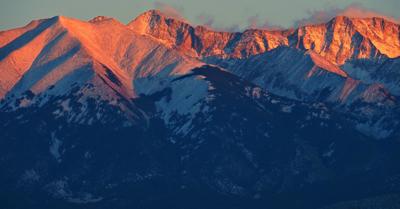Climbing a 14,000-foot peak is a quintessential Colorado hiking experience. Colorado’s high peaks offer a stunning array of ecological zones, each with its own flora and fauna adapted to that particular elevation and weather. To illustrate what to expect, we chose 14,345-foot Blanca Peak, which rises dramatically 6,500 feet above the floor of the San Luis Valley, passing through all the ecological zones of the Colorado Rockies in the process.

1. Pinyon-Juniper Woodlands
For those without high-clearance vehicles, the hike up Blanca Peak starts here at 8,000 feet, a landscape dominated by short, rounded pinyon and juniper, with ground covered by cactus and yucca. Rain and snow are scarce here compared to higher up, a desert-like environment where you may hear coyotes at night and the songs of birds like flycatchers, pinyon and scrub jays, and sparrows during the day.
RELATED: Oldest Living Tree Near Pikes Peak

2. Montane Conifer Forest
Lake Como Road has a reputation as one of the nastiest roads in Colorado, and most passenger vehicle drivers stop at around 8,800 feet and start walking. Here the trees get larger: Ponderosa pine and Douglas fir dominate this zone thanks to heavier precipitation and cooler temperatures. Aspen trees begin to appear as well. Look for Abert’s squirrel (which is black unlike the varieties in town), mule deer, and hawks, among other birds.
RELATED: Local’s Guide to Fall in Telluride

3. Subalpine Forest
At around 9,500 feet (a little higher in the southern mountains, thanks to warmer temperatures) the landscape changes. Aspen trees grow in meadows or burn scars, while Colorado’s mighty evergreens tend to dominate the canopy. This is where the terrible Lake Como Road ends, at nearly 11,500 feet at the namesake lake. This is classic Rocky Mountain scenery, a pretty lake ringed with pines and dominated by high craggy peaks. Columbines, the Colorado state flower, thrive in this zone in early summer. Black bears, elk, moose, and mountain lions call this zone home, though the odds of seeing mountain lions are small. Noisy chickadee, Stellar’s jay, and the gray jay are common birds here.
RELATED: Colorado’s Most Hikeable Glacier

4. Alpine Tundra
Past Lake Como, the trail rises above timberline and into the alpine tundra. Pine trees give way to twisted bristlecone pines, and then the trees disappear altogether, at around 12,000 feet on southern peaks like Blanca. The air is too thin and the temperatures too cold for trees beyond this altitude, so this is the domain of grasses and, in early to mid-summer, a dizzying array of wildflowers. Animals need to be hardy to stay alive here. Marmots and pikas skirt out from under rocks and chirp warnings at your approach, while birds that prey on them, such as peregrine falcons and golden eagles, circle overhead. Larger mammals include Rocky Mountain bighorn sheep and mountain goats, though the goats are a non-native species introduced to Colorado by miners.
RELATED: 10 Steepest Mountain Passes in Colorado

5. The Summit
As you climb higher on Blanca and pass Crater Lake at 12,650 feet, most vegetation disappears. The setting becomes a rocky lifeless moonscape, nothing but scree, talus, and boulders. The marmots still survive here, but little else appears to. On many high mountains, such upper slopes are steep and forbidding and the rocks loose and eroding. You can’t quite call it ‘the death zone’, that moniker is reserved for the terrain above 26,000 on the world’s highest mountains. But with such exposure to winds and weather, freezing temperatures most of the year and copious amounts of snow, you can see how it would be hard for an animal to make a living here.








(0) comments
Welcome to the discussion.
Log In
Keep it Clean. Please avoid obscene, vulgar, lewd, racist or sexually-oriented language.
PLEASE TURN OFF YOUR CAPS LOCK.
Don't Threaten. Threats of harming another person will not be tolerated.
Be Truthful. Don't knowingly lie about anyone or anything.
Be Nice. No racism, sexism or any sort of -ism that is degrading to another person.
Be Proactive. Use the 'Report' link on each comment to let us know of abusive posts.
Share with Us. We'd love to hear eyewitness accounts, the history behind an article.